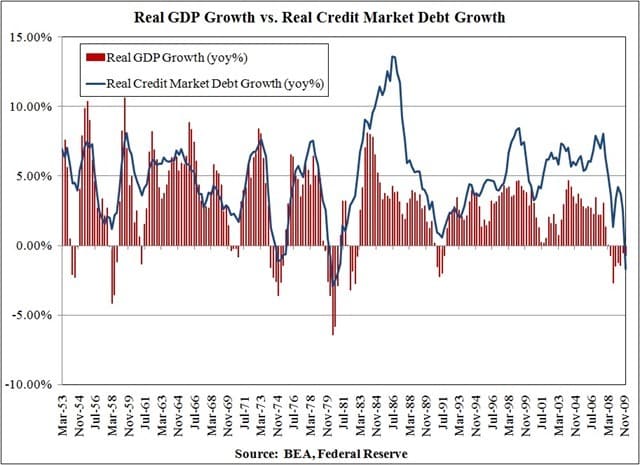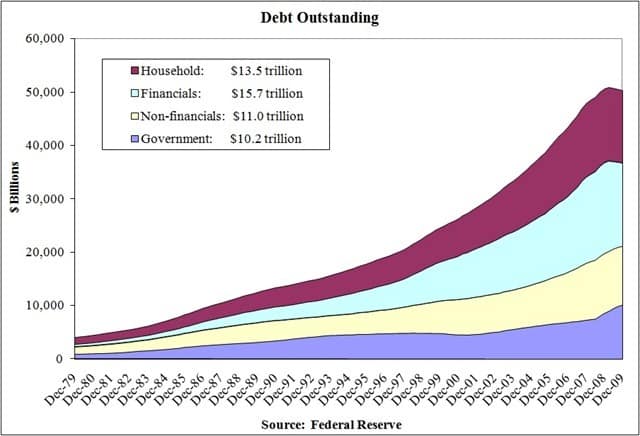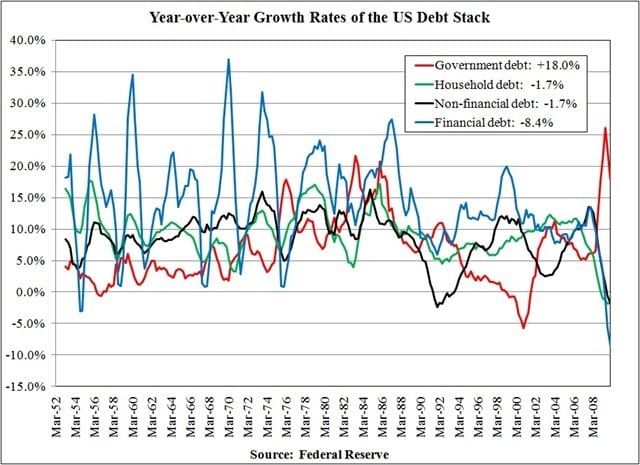Debt Growth Drives GDP Growth
By Annaly Salvos.
We breathlessly await the release of the next Z.1 from the Federal Reserve on June 10 to check on a number of things, such as the change in the amount of equity in the average American’s home in the first quarter, but we also look to update the graph below, which measures the real rate of growth in credit market debt against the real rate of growth in GDP. It’s a graph we have maintained for some time (thanks, Gary Gordon), and what it shows is something we all intuitively know: In the US, GDP growth and credit creation go hand in hand.
We were reminded of the graph by the release of the new consumer credit numbers yesterday by the Federal Reserve. While the total rose for the first time in three months—by $1 billion in April—the previous month was restated from a $2 billion increase to a $5.4 billion decline. The graph below shows the rise in debt outstanding in the four main categories of the US debt stack—household debt (mainly mortgage debt), financial debt (mainly market-related financing), non-financial debt (mainly corporate debt) and government debt (both federal and state & local). The legend in the graph gives the latest data point for each. For government debt, the total is comprised of $7.8 trillion in Federal debt and $2.4 trillion in state & local government debt
There has been a dip in debt outstanding for most of the US debt stack. The busy graph below gives the year-over-year growth rates in each category. Let us help you cut through the clutter of the spaghetti strands of lines to the main point of this mini-essay: the only part of the US debt stack that is growing is government debt. Breaking down the government portion, the Federal debt is growing 22.7% and state & local is growing 4.8%. Year-over-year Federal debt growth has averaged 28.2% over the last 5 quarters. In a private-sector deleveraging like we are experiencing, growth slows and the government tries to pick up the slack. Obviously, this policy has its consequences…



Thanks for the useful and timely post. I’ve been mulling something over, and I was hoping you could clarify. What’s the functional difference between debt and credit? Is it quite simply that debt is that portion of credit that’s been drawn down?
What categories are you including in your real credit market debt growth series? Because you find in general, private credit growth lags GDP growth, and government credit growth leads…and so an all in measure, which is basically coincident at best, at least at most turning points in your chart, is not so helpful if you are in the business of anticipating where things are going, which I presume was your objective given the title of the chart.
Given a rather obvious relationship, spending and especially credit spending, and its inverse, debt, it’s something we should have been very careful to regulate and make sure large excursions from what is payable (bubbles) were not occurring.
I mean, I can tell when something is not affordable – it’s not hard at all – which tells me if I’m engaged in bubble activities that will bite me.
So why can’t the Fed, or other CBs?
You’d think a Central Banker would be centrally focused on this, if they were interested in the on-going functionality of a financial system.
“There are some signs that the private sector is picking up the baton and moving the economy forward.” … “The recession is too deep, the loss of tax revenue is too great, the spending to try and support the economy and the financial system too large.” … “We are going to have to make a judgment about when is the appropriate time to begin moving and begin moving towards a more normal policy,” … “but doing that in a way that anticipates where the economy is going to be a year or a year and a half down the road.” – Ben Bernanke, June 07 2010
Ignoring the massive self-contradiction, ‘anticipating’ the US economy 12 to 18 months out? … because he’s got such a great track record … per mid-2007.
Unfortunately, he paid no attention to the obvious case that strong GDP growth and strong credit growth have a very fragile feedback relationship.
Now all the Kings Horses and all the King’s men can not put Humpty-Dumpty back together again. Really should have given young and silly Humpty some training and supervision about sitting on very high GDP walls propped up by easy credit.
Seems to me Bernanke and cohort didn’t actually think or realize an economy is a fragile thing, and the more unstable you make it, or allow it to become, the more it’s likely to be unfixable, via papering over the cracks?
Because when it breaks this badly, all you have holding Humpty together … is … paper.